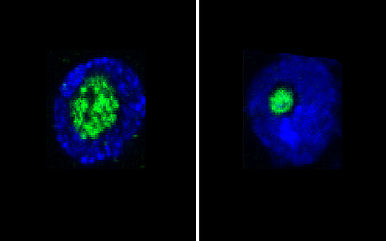Nucleolus is a life expectancy predictor

Long-lived fruit flies (right) have smaller nucleoli than their shorter-lived relatives (left). Source: Max-Planck-Institut für Biologie des Alterns
Can a cell show its biological age? And is it possible to foresee an animal’s lifespan? Scientists from the Max Planck Institute for Biology of Ageing in Cologne discovered a connection between the size of the nucleolus – a tiny structure in the very center of the cell – and life expectancy. This could be used as a molecular marker for health and ageing.
Ageing researchers have long been searching for so-called biomarkers of ageing, which allow predictions about health and lifespan of organisms. Varnesh Tiku, a scientist in the department of Director Adam Antebi at the Max Planck Institute for Biology of Aging, recently made a breakthrough discovery by studying long-lived mutants of the roundworm Caenorhabditis elegans.
All of the mutants showed smaller nucleoli than their shorter-lived relatives, independent of the pathway that led to their longevity. The nucleolus is a tiny structure within the cell nucleus where special RNA molecules and proteins are assembled to form ribosomes, the protein factories of cells. The strong correlation between nucleolar size and lifespan enables the Max Planck scientists to predict whether the worm will be short-lived or long-lived.
Human muscle biopsies
“We also observed reduced nucleolar size in long-lived animals from other model organisms, such as fruit flies and mice”, explains Antebi. “This correlation may even hold true in humans. When we analyzed muscle biopsies from individuals older than sixty years that underwent modest dietary restriction coupled with exercise – a common way to prolong lifespan and increase health – we found that they had smaller nucleoli in their muscle cells after the intervention than before.”
“Chicken or egg”?
But is the reduced nucleolar size actually responsible for the increased life expectancy or is it just a read-out without being causal? “We think that the size of the nucleolus is not only a biomarker for longevity, but that the molecules within the nucleolus could causally impact life expectancy”, explains Antebi. The scientists already got a glimpse that this hypothesis is correct:
They observed that long-lived mutants with small nucleoli also show reduced levels of a nucleolar protein called fibrillarin, which aids in the assembly of the protein factory. When fibrillarin was reduced, the roundworms lived longer. This suggests that levels of fibrillarin in the nucleolus regulate life span.
But do these results mean that in the future we could go to the doctor, measure our nucleoli and estimate our life expectancy? “Perhaps, but there is still a lot of work to be done – more importantly, we hope that our discovery will help us to monitor interventions associated with increased health and longevity”, says Antebi.
The research of Adam Antebi is supported by the Max Planck Foundation.
https://www.age.mpg.de/public-relations/news/detail/nucleolus-is-a-life-expectan…
https://www.nature.com/articles/ncomms16083?WT.feed_name=subjects_genetics
Media Contact
More Information:
http://www.age.mpg.deAll latest news from the category: Life Sciences and Chemistry
Articles and reports from the Life Sciences and chemistry area deal with applied and basic research into modern biology, chemistry and human medicine.
Valuable information can be found on a range of life sciences fields including bacteriology, biochemistry, bionics, bioinformatics, biophysics, biotechnology, genetics, geobotany, human biology, marine biology, microbiology, molecular biology, cellular biology, zoology, bioinorganic chemistry, microchemistry and environmental chemistry.
Newest articles

Sea slugs inspire highly stretchable biomedical sensor
USC Viterbi School of Engineering researcher Hangbo Zhao presents findings on highly stretchable and customizable microneedles for application in fields including neuroscience, tissue engineering, and wearable bioelectronics. The revolution in…

Twisting and binding matter waves with photons in a cavity
Precisely measuring the energy states of individual atoms has been a historical challenge for physicists due to atomic recoil. When an atom interacts with a photon, the atom “recoils” in…

Nanotubes, nanoparticles, and antibodies detect tiny amounts of fentanyl
New sensor is six orders of magnitude more sensitive than the next best thing. A research team at Pitt led by Alexander Star, a chemistry professor in the Kenneth P. Dietrich…





















